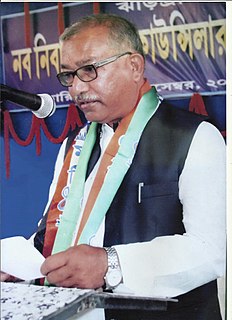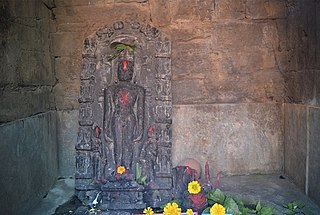Related Research Articles

Ghatshila is a census town in the Ghatshila CD block in the Ghatshila subdivision of the East Singhbhum district, in the Indian state of Jharkhand.
The region have been inhabited since the Stone Age. Copper tools from the Chalcolithic period have been discovered. This area entered the Iron Age during the mid-2nd millennium BCE.

Dhalbhum was the name given to parganas Supur and Ambikanagar in the Khatra area of present Bankura district in the Indian state of West Bengal. In the course of time, Dhalbhum kingdom was spread over a much wider area, across the western part of adjoining Midnapore district and the eastern and south-eastern parts of Singhbhum district in present-day Jharkhand.

Chuar rebellion or Chuar revolt, also known as Jungle Mahal movement was a series of peasant movements between 1766 to 1816 by the tribal inhabitants of the countryside surrounding the Jungle Mahals settlements of Midnapore, Bankura and Manbhum against the rule of the East India Company(EIC). This was the first revolt against the East India Company(EIC) in Chotanagpur areas of Bengal Presidency.

The Raikut family was a princely family that controlled large estates in Jalpaiguri what is now West Bengal, India, first as subjects to the state of Koch Bihar, later as Zamindars to the Mughal rulers of Bengal, and then to British Raj. Their story parallels that of the Bardhaman Raj, from the same region.
Dhalbhumargh is a village in the Dhalbhumgarh CD block in the Ghatshila subdivision of the East Singhbhum District in the Indian state of Jharkhand.

Chhatarpur was one of the princely states of India during the period of the British Raj. The state was founded in 1785 and its capital was located in Chhatarpur, Madhya Pradesh.

The Nagvanshis of Chotanagpur, was an ancient Indian dynasty which ruled the parts of Chota Nagpur plateau region during much of ancient, medieval and modern period. Phani Mukut Rai is considered the first king of dynasty claim to be son of Pundrika Naga a mythical Naga. Lal Chintamani Sharan Nath Shahdeo (1931–2014) was last ruling king of the dynasty, until the estate was merged to the Republic of India.

Jhargram Raj was a zamindari which occupied a position in Bengal region of British India. The zamindari came into being during the later part of the 16th century when Man Singh of Amer was the Dewan/Subahdar of Bengal (1594–1606). Their territory was centered around present-day Jhargram district. Jhargram was never an independent territory since the chiefs of the family held it basically as the zamindars of the British Raj in India after Lord Cornwallis's Permanent Settlement of 1793. Although its owners were both rich and powerful, with the chiefs of the family holding the title of Raja, the Jhargram estate was not defined as a Princely State with freedom to decide its future course of action at the time of Indian independence in 1947. Later, the Vice-Roy of India agreed to recognize Jhargram as "Princely State" after the Second World War, but the proposal taken back as the British had decided to give independence to India.

Shivendra Bijoy Malla Deb, known as Durgesh Da, is an Veteran Indian politician. He is from Jhargram, West Bengal.

Lakhahi Raj was a prominent Zamindari estate in the former State of United Provinces of British India. It was established in about 1461 as Usiya(an independent kingdom). Its first king was Maharaja Kalyan Mal and last ruling chief was Raja Viswanath Bux Singh. Lakhahi Raj was ruled by Rathore dynasty.

Chintamoni Dhoba, was ruler of Dhalbhum region and established capital at Ambikanagar. Chintamoni belonged to the Dhobi caste. The 'pai' or grain measure used in these parganas was for a long time called 'Chintamon pai'.
The Bhumij Rebellion or Bhumij Revolt, also known as Ganga Narain's Hungama was a revolt during 1832–1833 by Bhumij tribals based in the Dhalbhum and Jungle Mahal areas of the Midnapore district of the erstwhile Bengal state. It was led by Ganga Narayan Singh. The British have called it "Ganga Narayan's Hungama" while historians have also written it as the Chuar rebellion.
Rani Shiromani was the queen of Karnagarh, during the British rule in India. She was a valiant leader of peasants who rebelled against the British East India Company. she played a major role in the Chuar rebellion in Midnapore. She created the first revolt against the British through the farmers in Midnapore. She was against the British East India Company and refused to pay taxes. Thus, she was called as the Rani Laxmi Bai of Midnapore.
Raghunath Singh (Bhumij) was a great leader of Chuar rebellion of Bengal. Singh was a zamindar of Dampara of Ghatsila in Bengal. He led the Chuar rebellion in 1813 in Midnapore district against the British East India Company.
Baidyanath Singh or Baijnath Singh was one of the leaders of the Chuar rebellion. He led the rebellion against British rule in 1809-10 and died fighting against the British.
Durjan Singh was a great leader of Chuar rebellion of Bengal. Singh was a zamindar of Raipur in Bengal. He led the Chuar rebellion in 1798-99 in Midnapore district against the British East India Company.
Raja Jagannath Singh was an Indian revolutionary and a great leader of the Chuar rebellion. He was first to revolt against the British East India Company in Bengal Presidency in 1766. Many historians had mentioned him as Jagannath Patar.
Raja Jagat Deb, also known as Raja Jagannath Dhabal Deb I was founder of Dhalbhum Raj in Khatra region of Bengal. He was the king of Dhalbhum during the 13th century. He was the second son of Raja Bhoj II of Dhara.
Dhal rebellion or Dhalbhum Uprising was the rebellion against the British in present-day Jharkhand state. The 'Dhal rebellion' means the rebellion of the people of the entire Dhal kingdom under the leadership of the Raja of Dhalbhum, Raja Jagannath Dhal.
References
- ↑ Rathore, Abhinay. "Dhalbhum & Jamboni (Zamindari)". Rajput Provinces of India. Retrieved 2022-09-18.
- ↑ Bhardwaj, Dr Kamal (2002-01-01). History of Modern India. Prabhat Prakashan. ISBN 978-93-5266-745-1.
- ↑ India's Struggle for Freedom: An Album. Department of Information & Cultural Affairs, Government of West Bengal. 1987.
- ↑ Chand, Tara (1965). History of Freedom Movement in India - Vol 2. Publications Divisions, Ministry of Information and Broadcasting. ISBN 978-81-230-2447-9.
- ↑ Rathore, Abhinay. "Dhalbhum & Jamboni (Zamindari)". Rajput Provinces of India. Retrieved 2022-09-18.
- ↑ J, Reid (1912). Final Report on the Survey and Settlement of Pargana Dhalbhum in the District of Singhbhum, 1906 to 1911. Bengal Secretariat Book Departmentôt.
- ↑ Majumdar, Ramesh Chandra (1963). The Sepoy Mutiny and the Revolt of 1857. Firma K. L. Mukhopadhyay.
- ↑ Sen, Sailendra Nath (1979). History of Modern India, 1765-1950. Wiley Eastern. ISBN 978-0-85226-812-4.
- ↑ Das, Binod Sankar (1973). Civil Rebellion in the Frontier Bengal, 1760-1805. Punthi Pustak.
- ↑ Chaudhuri, Sashi Bhusan (1955). Civil Disturbances During the British Rule in India, 1765-1857. World Press. ISBN 978-0-598-57785-6.
- ↑ Pravīra (2001). Jhārakhaṇḍa prophāila (in Hindi). Abhiyāna.
- ↑ Das, Binod Sankar (1984). Changing Profile of the Frontier Bengal, 1751-1833. Mittal Publications.